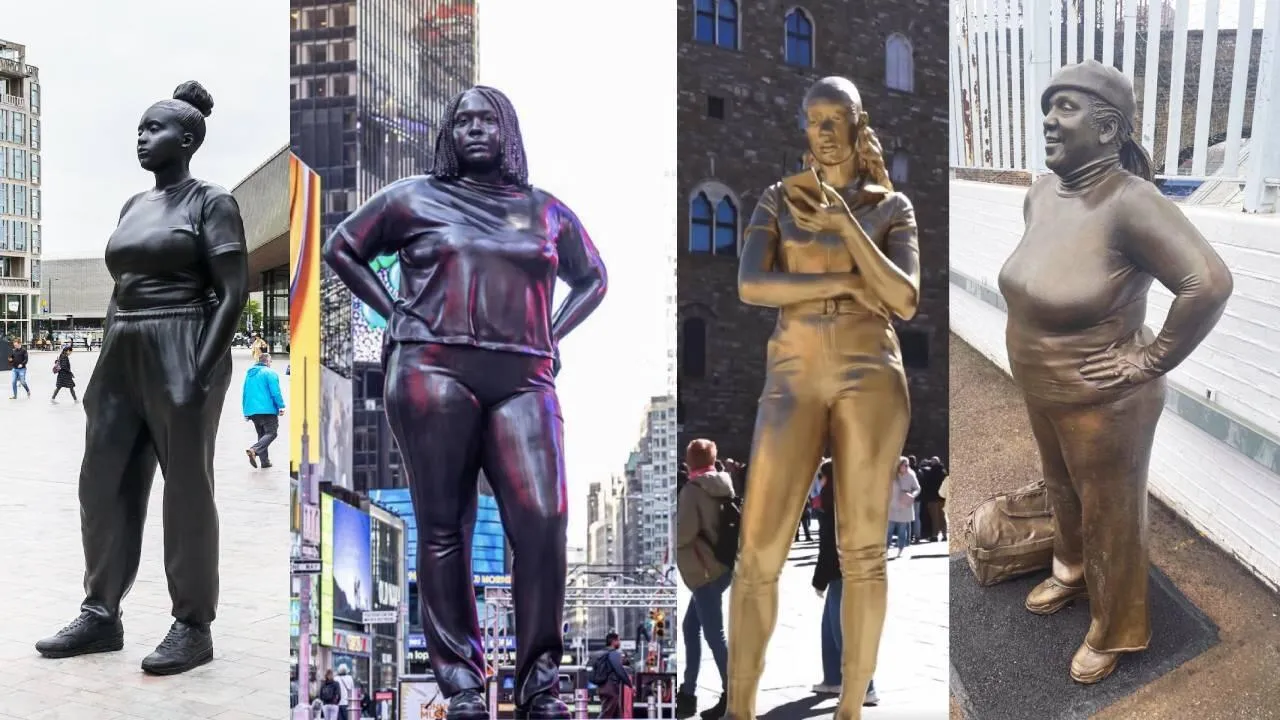If you want to gauge the health of a nation, look at its art.
When a society starts swapping out its majestic monuments for fat, sagging figures, you know the commies are knocking, ready to smother the human spirit under a pile of ideological concrete.
Enter the latest travesty in Manhattan’s Times Square: welcome to the downfall, sculpted in bronze.
The statue, "Grounded in the Stars," unveiled in Manhattan’s Times Square, sparking debate over its purpose and artistic merit.
Created by British artist Thomas J. Price, the sculpture depicts a fictional, obese black woman with a blank expression, slumped posture, and a loose-fitting shirt.

Positioned in Duffy Square—the northern triangle of Times Square between 45th and 47th Streets and Broadway, the statue stands in contrast to existing statues of Father Francis Duffy and George M. Cohan, which celebrate historical figures.
Price claims his monument is a "disruption of traditional ideas" about triumphant figures, aiming to provoke "introspection on humanity" and foster "cultural diversity," according to his website.
My critique of this statue has nothing to do with race.
— Not the Bee (@Not_the_Bee) May 7, 2025
Make the subject white, black, hispanic, it doesn’t matter. A woman with a body like this in a frumpy t-shirt standing in a position of entitlement and laziness is a glorification of mediocrity in every way. pic.twitter.com/5ebVjX2SQn
The statue replaces earlier monuments, including those of Theodore Roosevelt and Thomas Jefferson, removed as Democratic lawmakers rallied against symbols of the Confederacy, slavery, and colonialism, arguing the statues glorified oppression.
Death of civilization is when statues honoring our Founding Fathers and Military Heroes who sacrificed EVERYTHING are being replaced with hideous WOKE monstrosities like some anonymous obese black woman installed in Times Square who accomplished absolutely NOTHING!! pic.twitter.com/DJmZuLISul
— 💥Hank💥 (@HankishTwitZone) May 8, 2025
Ironically, the Democratic Party—historically the party of the Confederacy during the Civil War—fought to preserve slavery and later enacted Jim Crow laws and supported groups like the Ku Klux Klan.
Rather than honor notable black women like Harriet Tubman, Daisy Bates, or Maya Angelou, New York City opted to glorify a generic figure that some see as a caricature, stereotyping black women as unattractive and fat.
Cities worldwide are swapping heroes for blobs, and heritage for ideology.
Rotterdam as well. Already for a few years. An uninterested looking girl in sweatpants and sneakers. pic.twitter.com/HUL3CgqBuG
— Henri (@road2nowherex) May 7, 2025
While supporters praise these statues for their challenge to conventional representations of power and identity, calling the statue a bold statement on "inclusivity," the glorification of ugly art is historically one of the "45 Declared Goals of Communism to Take Over America."
The document, which gained notoriety during the Cold War, outlines a comprehensive list of communist strategies for undermining American society.
The list was entered into the Congressional Record in 1963 and Rep. Albert S. Herlong Jr., D-Fla, read it aloud on the House floor to warn of subversive tactics.
Among the goals are directives to "degrade all forms of artistic expression" by eliminating “good sculpture from parks and buildings” and substituting "shapeless, awkward, and meaningless forms," as well as to “control art critics and directors of art museums" to "promote ugliness, repulsive and meaningless art."
The document, drawn from Cleon Skousen’s 1958 book The Naked Communist, circulated widely among anti-communist groups and was debated in Congress as evidence of a cultural threat.
Excited to reveal the winning #FourthPlinth artworks for 2026 & 2028 in Trafalgar Sq 🏛️ Lady in Blue by Tschabalala Self & Untitled by Andra Ursuţa!
— Justine Simons OBE (@justinesimons1) March 15, 2024
Congratulations to all the shortlisted artists & big thanks to the Commissioning Group & our incredible partners ✨️ pic.twitter.com/e4XYAtxVpd
Ugly art isn’t just a crime against aesthetics—it’s the calling card of a communist takeover.
The Grounded in the Stars installation embodies these goals, replacing heroic imagery with forms that demoralize rather than inspire.
The statue of some fat lady in the heart of the Big Apple also draws parallels to a 1999 controversy at the Brooklyn Museum, where the progressive art world championed The Holy Virgin Mary by Chris Ofili, a painting that was made with elephant feces.

Then-Mayor Rudy Giuliani, a vocal critic, threatened to cut city funding to the museum, calling the piece "sick" and arguing that it was not art but an attempt to shock and degrade.
Giuliani’s legal battle with the museum escalated to federal court, where a judge ruled in favor of the museum’s First Amendment rights.
The episode became a flashpoint in the culture wars, with conservatives decrying the exhibit as an example of cultural decay and liberals defending it as free expression.
From Michelangelo... to meh.












Conversation